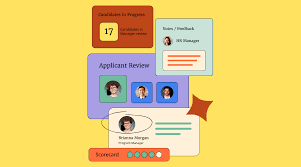How Applicant Tracking Tools Improve Fair Hiring Practices
In today’s rapidly transforming employment landscape, the call for fair and equitable hiring practices has become a top priority for organizations across all industries. The growing emphasis on diversity, equity, and inclusion compels companies to reexamine outdated recruitment methods and adopt tools that foster fairness at every stage of the hiring process. The advent of technology-driven solutions, particularly the enterprise applicant tracking system (ATS), has significantly transformed the hiring process for businesses. These innovative platforms don’t just help manage candidates—they actively ensure inclusivity, consistency, and objective assessment, all while streamlining the recruitment process and eliminating the influence of human error or bias-prone manual evaluation. With ATS, organizations are better positioned to achieve their diversity goals, save valuable resources, and create a more inclusive and welcoming work environment for all.
The widespread adoption of applicant tracking systems is overhauling every facet of the recruitment process. These systems automate routine administrative tasks, freeing up time for more thoughtful candidate engagement. Most importantly, however, they inject a higher degree of fairness and transparency into the hiring pipeline. By providing a standardized approach to evaluating every candidate, ATS guarantees that all applicants—regardless of their background, demographics, or networks—enjoy an equal opportunity to demonstrate their qualifications and advance in the selection process. This impartiality is at the heart of what makes modern recruitment more transparent and just, setting the stage for more diverse, talented, and satisfied teams.
Standardizing the Recruitment Process
At the core of every fair hiring initiative is the need for standardization, and this is one of the primary advantages offered by applicant tracking tools. ATS platforms funnel all applicants through clearly defined and repeatable workflows, ensuring that the process remains consistent regardless of who applies or who reviews the applications. Every candidate submits their materials through the same portal, goes through uniform screening steps, and is evaluated based on explicitly outlined criteria. Automated scoring systems and pre-built evaluation templates help reduce personal judgment and eliminate ambiguity, which are key contributors to hidden bias. With automated reminders and role-based access, even the flow of communication and feedback is managed in an equitable manner.
Implementing Blind Screening Techniques
Unconscious bias is a deeply rooted challenge in traditional hiring—a challenge that often arises from factors such as gender, ethnicity, age, or even alma mater, none of which should influence hiring decisions. Here, applicant tracking tools wield blind screening as a powerful antidote. Using blind screening features, ATS platforms can systematically strip away personally identifiable information from job applications during the early review stages. Names, birthdates, addresses, photos, and even certain educational or employment details can be hidden from hiring managers, ensuring the first impression is based solely on job-relevant qualifications. This approach prevents unintentional prejudice from influencing decision-making and allows skills and experience to take center stage. Evidence consistently shows that blind screening reduces the sway of cultural and societal biases, making it possible for more candidates from diverse backgrounds to be considered fairly and equitably.
Utilizing Data Analytics for Diversity Monitoring
Applicant tracking systems don’t just standardize the process—they also bring a new level of data-driven insight to recruitment. Today’s advanced ATS platforms offer comprehensive analytics dashboards that monitor a wide array of hiring metrics, including demographic representation at each pipeline stage, conversion and drop-off rates, interview feedback trends, and overall candidate satisfaction. Regular analysis of these data points enables HR and talent acquisition teams to identify patterns in candidate progression and pinpoint systemic barriers that may inadvertently restrict diversity. This data enables organizations to take swift, corrective action—whether that means redesigning job descriptions, adjusting screening criteria, or providing targeted training for interviewers. Additionally, real-time analytics support compliance with Equal Employment Opportunity (EEO) guidelines, enabling organizations to demonstrate their commitment to workplace equality and inclusivity. Ultimately, these insights can drive robust policies to create and maintain a more diverse and innovative workforce.
Facilitating Structured Interviews
Structured interviews represent a gold standard in fair candidate evaluation, and modern applicant tracking systems make their implementation seamless. By design, structured interviews ensure that every candidate is presented with the same questions in the same order, and responses are assessed against identical criteria. ATS platforms can automate every step of this process: delivering standardized interview scripts to hiring panels, collecting interviewer input through digital forms, applying automated scoring, and aggregating feedback for easy comparison. This approach drastically limits the impact of personal preferences or first impressions during candidate assessments. Additionally, interviewer consistency is maintained, regardless of who conducts the interview or when it takes place. By adhering to structured frameworks, organizations can be confident that each applicant is evaluated fairly, transparently, and without undue influence from cognitive or confirmation biases. The result is a more meritocratic recruitment pipeline, where talent and potential, rather than personal connections or subjective ‘fit,’ drive final decisions.
Regular Audits to Prevent Algorithmic Bias
As powerful as applicant tracking systems can be for countering human bias, it’s crucial to remember that algorithms themselves are not immune to inheriting historical inequities. If left unchecked, AI-driven tools can perpetuate or even amplify existing biases embedded in their training data or design assumptions. That’s why ongoing audits and accountability are vital components of any fair hiring strategy leveraging technology. Organizations must regularly review and test their ATS for signs of unintended discrimination by carefully scrutinizing system recommendations, examining pass-through rates for different groups, and updating algorithms with fresh, diverse datasets. External audits and stakeholder feedback are equally important to catch gaps that internal teams may overlook. Transparent reporting of audit results and a public commitment to continuous improvement not only strengthen trust in technology-driven hiring but also ensure that every stage of the process remains anchored to core principles of fairness and equity.
Conclusion
Applicant tracking systems are at the forefront of today’s movement toward fairer and more inclusive hiring. By enforcing standardized processes, enabling blind screening, empowering data-driven decision making, supporting structured interviews, and encouraging regular algorithmic audits, ATS provides organizations with the tools they need to cultivate unbiased talent acquisition. Adopting an enterprise applicant tracking system helps companies ensure legal compliance, enhance process transparency, and build more diverse teams, ultimately benefiting both business outcomes and workplace culture. As HR technology continues to advance, the possibilities for even greater fairness and opportunity will only grow, ushering in an era where every candidate, regardless of background, is afforded an equal chance to thrive.







